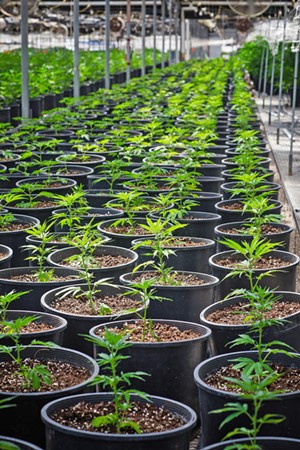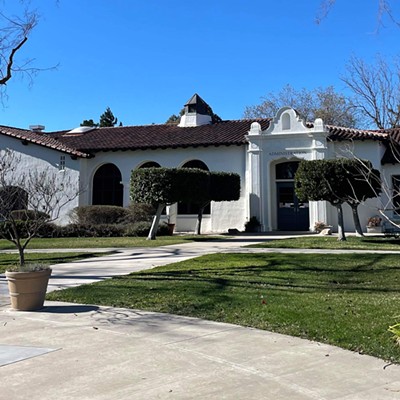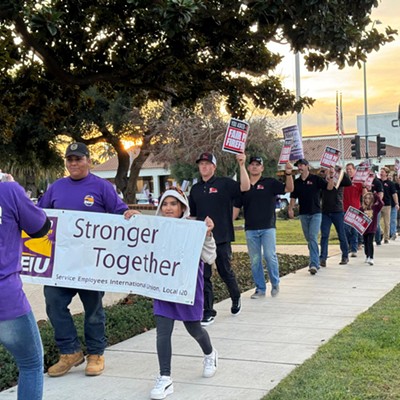When Santa Barbara County opened the doors to legal cannabis operations in 2017, officials designed a tax system without precedent.
“There was no model to work from because we were the first ones in the boat,” 5th District Supervisor Steve Lavagnino said.

During this time, consultants presented the county with two options: taxing the gross receipts or taxing by square footage, he said.
Gross receipts take a percentage of operators’ revenue, and square footage sets a dollar amount per operating square foot with prices varying between indoor and outdoor cultivation, he said. While many other counties with cannabis operations went with a square footage tax because of its simplicity, Santa Barbara County set a gross receipts tax and takes 4 percent of an operator’s earnings.
“What I like about a gross receipts tax is when the market’s great and the growers are making a lot more money, we bring in more. When the market is down, we also feel that and we don’t enjoy the profits,” Lavagnino said. “The problem with the gross receipts tax is you’re … holding the grower to say how much [they] grew and how much [they] made, and [we] get 4 percent of that.”
The gross receipts tax goes into the county’s general fund, helped establish a cannabis enforcement team to hinder illicit cannabis activities, and created positions in the Treasurer-Tax Collector’s Office that work full-time on cannabis projects. In five years, Santa Barbara County has generated $50 million—the second highest revenue in comparison to the top six cultivators in California: Monterey, Humboldt, Mendocino, Santa Cruz, and Sonoma.
However, tax compliance challenges, a lack of a forecasted revenue, and tax reporting transparency concerns—specifically regarding the value of an operator’s product per pound—are bringing the cannabis tax back to the drawing board, Santa Barbara County Deputy Executive Officer Brittany Odermann said.
“A bunch of people have said to me, ‘Nothing gets scrutinized like this [cannabis],’” Odermann said. “It’s confidential and self-reported in all businesses in the county, not just cannabis. That’s been a frustration for the industry, but my job as staff … is to say this rate looks really low because the process by which these folks are taking this product and sending it out of the county, they are valuing that product at a rate that appears to be lower than it should be.”
While the treasurer-tax collector’s new audit system should help identify if cannabis operators undervalue their products, the county Board of Supervisors directed staff in 2023 to explore other options that would improve transparency, provide more certainty to operators, and create greater predictability in forecasting revenues, according to county documents.
During the March 12 Board of Supervisors meeting, the County Executive Office presented a square footage tax or cannabis product weight tax as options to bring to the voters as a ballot measure in the November general election.
After more than two hours of discussion, supervisors voted 4-1 (with Lavagnino dissenting) to direct staff to conduct further research into a square footage model and come back with a hybrid option that would blend the gross receipts model with a flat square footage rate. The County Executive Office is set to come back to the board in May to discuss their findings, and four out of the five Supervisors must approve the measure for it to go on the November ballot, Odermann said. The measure would then need a simple majority vote for it to be adopted.
“If [we] don’t get it on the November ballot, it’s another two years with the system we currently have—that might be a good thing or a bad thing,” Supervisor Lavagnino said.
Lavagnino added that he dissented because the gross receipts model has only been in place for five years—not enough time to get an accurate picture of incurring revenues nor enough time to see the results of the treasurer-tax collector’s recently established audit system.
“It’s been proven out over the five years we are one of the top counties in revenue, and I don’t want to mess with it,” he said.
While taxing by square foot is one of the most common methods used by local jurisdictions, price declines and state cultivation tax resulted in growers owing more in taxes than they earned in revenue, causing operators to close, according to the March 12 county staff report.
Square footage tax breaks down prices by indoor cultivation, outdoor cultivation, and nurseries. Prices are adjusted annually by the consumer price index or with a Board of Supervisors vote.
While it’s straightforward, Lavagnino said that this route runs into challenges with outdoor cultivation because weather impacts may cause people to lose their crops one year, and operators may have to pay more than what they made because cannabis products are valued at different rates depending on how they are processed.
Monterey County adopted a square footage tax when the county established its system in 2016. It charged operators $15 per square foot for indoor operations, but didn’t have outdoor grows at that time, according to county documents. In eight years, Monterey’s adjusted its cannabis tax six times and now charges $2.13 per square foot for indoor grows, and 71 cents per square foot for outdoor grows.
Lake County started off with a $3 per square foot indoor tax and $1 per square foot outdoor, and reduced their rates by 50 percent, according to county documents. Other counties did a “tax holiday” where they aren’t charging anything, Lavagnino said.
“I think there are too many holes; when I look at other counties with that system, it’s not the cure-all, it’s not the golden pill,” he said.
During the March 12 discussion, 3rd District Supervisor Joan Hartmann suggested a hybrid between the gross receipts model and a square footage tax, where the county would set a minimum tax based on square footage with a gross receipts tax if operators exceed a certain threshold in revenue.
“For our county concessions for example at Jalama, it’s a percentage rent so there’s a base rent and we share in the gross receipts, and that might be something to think about in the light of cannabis,” Hartmann said during the meeting. “It seems that we still have to figure out what rate and that gets tricky, but I think the structure of going on a square footage at a minimum and gross receipts, it has some benefits for us.”
The county can still share in the good times, but there will still be a base amount and it provides flexibility for the growers as well in terms of cultivation, Hartmann said.
Lavagnino told the Sun that the hybrid model would be an interesting option, but he’d hate to “be the first person in the pool.”
“I’d like to see it fleshed out, but that might be the way you do it where you create an alternative minimum tax that everybody has to pay and if you exceed something you share in the profit,” he said.
Odermann told the Sun that there are a couple of counties that have hybrid models, but their ordinances are written where they have more flexibility in how they administer the tax.
“Nevada County has a minimum tax that says for up to this amount of canopy you pay this amount per harvest. They look at cultivation cycles, then it’s tiered for how big the operation is, and the price goes up,” she said. “At the end of the year, they report their gross receipts and if they owe anything they get a bill; if they don’t, they pay the minimum and they’re good.”
Santa Barbara County is trying to figure out the simplest way to implement this without burdening current staff dedicated to cannabis, she said.
“You are now implementing two processes, you potentially have more staff resources needed to ensure that it’s all going smoothly given you are going to do billing on the front end and reconciling and doing billing on the back end,” Odermann said. “This adds another component that we currently don’t do.”
Reach Staff Writer Taylor O’Connor at [email protected].












